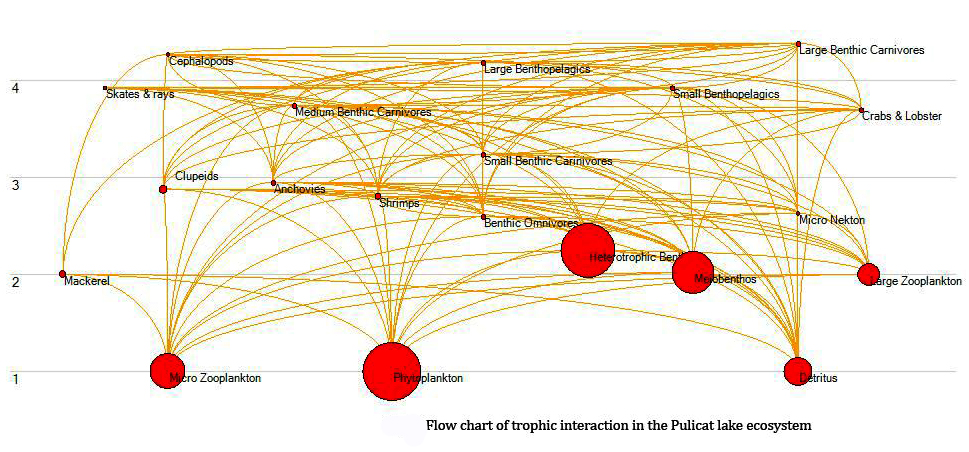Tropic Modelling of Pulicat Lake Ecosystem & Simulation of Fishery yields
A tropic mass-balance model of the marine ecosystem of the Pulicat lake incorporating energy flows between tropic levels and interaction between trophic components was constructed using the Ecopath with Ecosim (EwE Ver. 5.0) software. The Pulicat model encompassed an area of 350km² and 21 functional ecological groups of which Ecological groupings were made taking into consideration that within group, the species have similar food and similar predators, and they ranged from apex predators like skates, large benthic carnivores and small Bentho Pelagicus to micro zooplankton and detritus. The study period was from2009-2010 and an average picture during this period is presented. The input parameters used for the model fitting were the ecological group-wise estimates of production biomass (P/B)ratio, consumption biomass (Q/B)ratio, biomass, diet composition and fleet-wise and group-wise fishery catches. the quality of the inputted data was assessed with Ecopath pedigree index and the value obtained was 0.521(scale 0-1). The total system throughput represents the size of the entire system in terms of and was estimated for Pulicat lake ecosystem 9894.5 t /km²/year, which is comparatively high, but is consistent with tropical marine ecosystems with high turnover. The Pulicat model had a mean trophic level of 3.02, which the minimum being 1 (phytoplankton) and maximum 4.45 (clupeids). Gross efficiency of the fishery is computed as the ratio between the total catch and the total primary production in the system. For Pulicat model the value obtained was 0.0021(higher than the global average) indicating a fishery harvesting fishes low in the food chain. The Pulicat lake ecosystem is well known as being part where lower trophic level pelagic fishes dominate. The system omnivory index is a measure of how the feeding interactions are distributed between trophic levels. For the Pulicat Lake Ecosystem an index value of 0.248 was obtained. The total primary production by total respiration ratio is considered by Odum to be an important ratio for description of the maturity of an ecosystem. According to Odum’s classification the pulicatlake ecosystem is in a developing stage with ratio being greater than 1(1.356).the estimates of net system production and total primary production by total biomass ratio also indicated that the ecosystem is immature. The predation mortality rates (M2) were considerably higher than fishing mortality rate among the commercially ex ploited groups with respect to cephalopods (Grp 2) , large benthic carnivores (Grp 4), small benthic carnivores (Grp 6), anchovies (Grp 10), crabs and lobsters (Grp 12), shrimps (Grp 13), and benthic omnivores (Grp 14). This indicates the predation pressure exerted on these groups by other groups. The top 3 apex predator groups and tunas had no predatory pressure. The flows to detritus were maximum for phytoplankton and micro zooplankton followed by meiobenthos and heterotrophic benthos. The least flows were observed for apex predators. The omnivory index (OI) was calculated as the variance of the trophic level of a consumer’s prey groups. The maximum OI was observed for group 5 medium benthic carnivores, followed by group 9 clupeids and indicating feeding on a wide variety of preys. Highly specalized feeding (low OI) was observed for tunas and mackerel. Higher consumption was estimated for groups in the lower trophic levels. Maximum was observed for micro zooplankton (1338 t/km²/year).
 The prey and predator niche overlaps for pulicat lake indicates that tunas, cephalopods and large benthic carnivores have significant overlap in their diets with marine mammals. Maximum prey overlaps were observed for groups , medium benthic carnivores. Similarly, large pelegics and large benthopelagics had significant predator overlaps. Maximum predatory overlap was observed in the case of cephalopods. The selection indicates or electivity describe a predator’s preference for prey and in the pulicat lake pelegics, while it avoided small benthic carnivores and small benthopelagics. Group 5 medium benthic were very selective feeders (on benthic omnivores and large zooplankton) avoiding most prey groups. The search rates (volumes searched per unit time by a given predator j seeking a certain prey i) for groups of the pulicat lake indicated the higher trophic level groups had higher search rates than lower trophic level groups. Maximum primary production required for harvest of groups was observed for group 11 small benthopelagics, group 7 large benthopelagics and group 6 cephalopods. Maximum primary production required for consumption of groups was observed for lowertrophic level groups, viz., micro zooplankton, micro nekton, hertrophics benthos and anchovies. In the pulicat ecosystem higher trophic level groups had large ecological footprints (PPR per unit biomass) indicating that more resources were necessary to sustain their production. The mixed trophic impact analysis indicated that shore seines negatively impact mackerel and clupeids and gill net negatively impact on small benthopelagics . since anchovies are a food organisms for many groups, they have a positive impacts on cephalopods and small benthopelagics. The Pulicat lake ecosystem has relatively low ascendancy (43.5%) when compared to some other self systems. The systems is over head is approximately 56%. This suggest that the Pulicat lake ecosystem has significant strength in reserve and can either be resistant or resilient to perturbations with the capability to bounce back quickly to orginial levels . A trophic flow digram was constructed such that boxes representing organisms low in the food web are placed in the lower part of the graph, while the organisms high in the food web are put higher up. The boxes connected by means of trophic flows.The present ecological model constructed and the simulation made are a premilinary exercise and with the availability of better information and more vigorous data the model can be improved so as to reflect the reality in a better fashion. This study shows that ecological modelling is much better tool for management of multispecies fishery resources and should be applied to other major marine ecosystem in India
The prey and predator niche overlaps for pulicat lake indicates that tunas, cephalopods and large benthic carnivores have significant overlap in their diets with marine mammals. Maximum prey overlaps were observed for groups , medium benthic carnivores. Similarly, large pelegics and large benthopelagics had significant predator overlaps. Maximum predatory overlap was observed in the case of cephalopods. The selection indicates or electivity describe a predator’s preference for prey and in the pulicat lake pelegics, while it avoided small benthic carnivores and small benthopelagics. Group 5 medium benthic were very selective feeders (on benthic omnivores and large zooplankton) avoiding most prey groups. The search rates (volumes searched per unit time by a given predator j seeking a certain prey i) for groups of the pulicat lake indicated the higher trophic level groups had higher search rates than lower trophic level groups. Maximum primary production required for harvest of groups was observed for group 11 small benthopelagics, group 7 large benthopelagics and group 6 cephalopods. Maximum primary production required for consumption of groups was observed for lowertrophic level groups, viz., micro zooplankton, micro nekton, hertrophics benthos and anchovies. In the pulicat ecosystem higher trophic level groups had large ecological footprints (PPR per unit biomass) indicating that more resources were necessary to sustain their production. The mixed trophic impact analysis indicated that shore seines negatively impact mackerel and clupeids and gill net negatively impact on small benthopelagics . since anchovies are a food organisms for many groups, they have a positive impacts on cephalopods and small benthopelagics. The Pulicat lake ecosystem has relatively low ascendancy (43.5%) when compared to some other self systems. The systems is over head is approximately 56%. This suggest that the Pulicat lake ecosystem has significant strength in reserve and can either be resistant or resilient to perturbations with the capability to bounce back quickly to orginial levels . A trophic flow digram was constructed such that boxes representing organisms low in the food web are placed in the lower part of the graph, while the organisms high in the food web are put higher up. The boxes connected by means of trophic flows.The present ecological model constructed and the simulation made are a premilinary exercise and with the availability of better information and more vigorous data the model can be improved so as to reflect the reality in a better fashion. This study shows that ecological modelling is much better tool for management of multispecies fishery resources and should be applied to other major marine ecosystem in India
